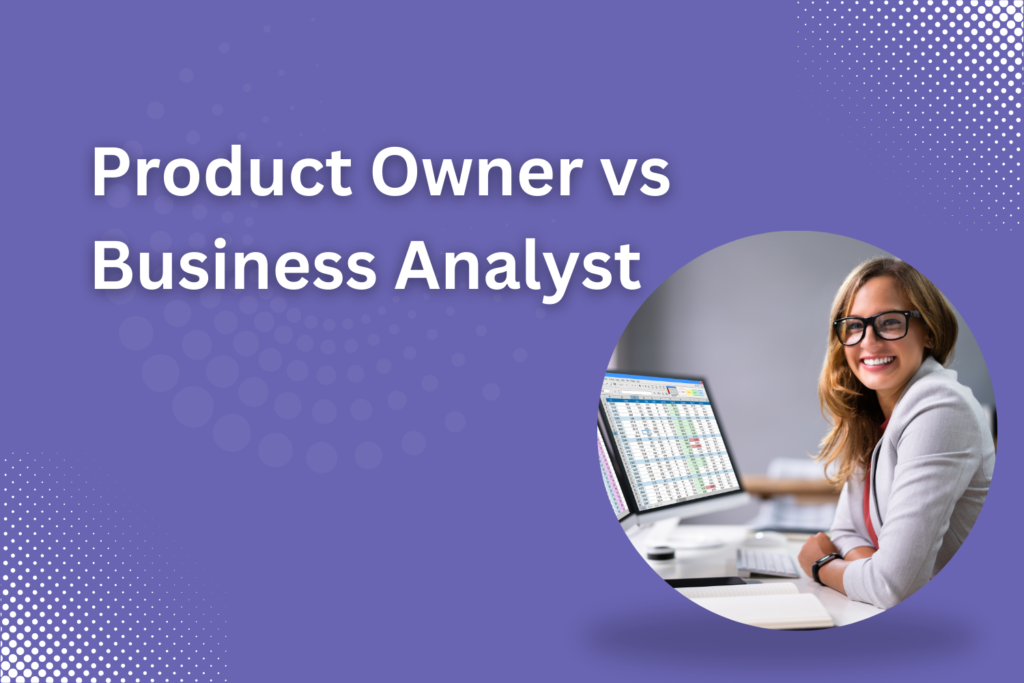In the intricate world of project management, the roles of Product Owner and Business Analyst stand as pivotal pillars, each contributing distinct expertise and perspectives to drive project success. Often used interchangeably or confused due to overlapping responsibilities, understanding the differences and synergies between these roles is crucial for fostering effective collaboration and maximizing project outcomes.
Table of Contents
Toggle1) Differences in the Roles of a Product Owner and a Business Analyst
Defining the Roles
A. Product Owner: Responsibilities, Scope, and Objectives
The Product Owner is a key figure in Agile frameworks, responsible for representing the interests of stakeholders, prioritizing requirements, and ensuring the delivery of value to customers. Their primary objective revolves around maximizing the value of the product through effective backlog management and clear communication of requirements to the development team.
B. Business Analyst: Responsibilities, Scope, and Objectives
On the other hand, the Business Analyst is primarily focused on bridging the gap between business stakeholders and IT teams. They analyze business processes, gather and document requirements, and ensure alignment between business needs and technological solutions throughout the project lifecycle.
C. Key Differences in Focus and Priorities
While both roles aim to enhance project outcomes, the Product Owner emphasizes customer value and product vision, whereas the Business Analyst focuses on requirements analysis and process improvement, ensuring alignment between business objectives and project deliverables.
2) Differences in Responsibilities and Deliverables of a Product Owner and a Business Analyst
Understanding Responsibilities and Deliverables
A. Product Owner’s Responsibilities in Agile Environments
In Agile methodologies, the Product Owner owns the product backlog, defines user stories, sets priorities, and makes decisions about feature releases. They are the key decision-makers regarding product functionalities, acting as the voice of the customer within the development team.
B. Business Analyst’s Responsibilities in Project Lifecycle
The Business Analyst operates across the project lifecycle, starting from requirements elicitation and analysis to solution implementation. They engage stakeholders, gather and document requirements, analyze processes, and facilitate communication between business and technical teams.
C. Overlapping and Unique Deliverables of Both Roles
While both roles involve gathering and analyzing requirements, the Product Owner focuses on defining the ‘what’ (customer needs and priorities), while the Business Analyst delves into the ‘how’ (detailed analysis and documentation) of meeting those needs.
3) Differences in Skills of a Product Owner and a Business Analyst
Core Competencies and Skill Sets
A. Essential Skills for a Successful Product Owner
Successful Product Owners exhibit skills such as strategic thinking, customer empathy, strong communication, backlog management, and an ability to make data-driven decisions based on customer feedback and market trends.
B. Critical Skills and Qualities of an Effective Business Analyst
Effective Business Analysts possess skills in requirements elicitation, process modeling, critical thinking, problem-solving, communication, stakeholder management, and a comprehensive understanding of business and technology domains.
C. Analyzing Skill Overlaps and Specializations
While both roles require strong communication, analytical thinking, and stakeholder engagement skills, Product Owners lean more towards strategic vision and decision-making, while Business Analysts excel in detailed analysis and documentation.
4) Differences in the role of a Product Owner and a Business Analyst in Agile Methodologies
Role in Agile Methodologies
A. Product Owner’s Integral Role in Agile Frameworks
The Product Owner is a core member of Agile teams, collaborating closely with Scrum Masters, development teams, and stakeholders to guide the product development process, ensuring that the team works on high-priority items aligned with customer needs.
B. Business Analyst’s Contribution and Position in Agile Teams
In Agile environments, Business Analysts often play roles such as Product Owner proxy, or team facilitator, adapting their analytical and communication skills to support the Agile delivery model.
C. Harmonizing Responsibilities within Agile Environments
In Agile settings, both roles complement each other by focusing on different aspects of the project lifecycle – the Product Owner aligns with the strategic vision, while the Business Analyst ensures that requirements are understood and translated effectively for implementation.
5) Differences in Specialized Roles of a Product Owner and a Business Analyst
Industry Variations and Specialized Roles
A. Industry-Specific Demands Impacting Product Ownership and Business Analysis
In different industries such as finance, healthcare, or technology, the expectations from Product Owners and Business Analysts might vary based on industry regulations, technological advancements, or customer demands.
B. Emerging Specializations within Product Owner and Business Analyst Roles
Specialized roles such as Domain Product Owner or Technical Business Analyst might evolve to cater to industry-specific needs, demanding expertise in niche domains or technical aspects of the product development lifecycle.
C. Tailoring Roles to Industry Requirements
To adapt to industry demands, Product Owners and Business Analysts may need to acquire specialized domain knowledge, certifications, or technical skills relevant to their industry to enhance their effectiveness in those domains.
Understanding the distinct roles and collaborative potential of Product Owners and Business Analysts is essential for harnessing their synergies in delivering successful projects. While the Product Owner navigates strategic vision and customer value, the Business Analyst ensures detailed analysis and effective communication within Agile frameworks and project environments. By recognizing their unique strengths and aligning their efforts, organizations can leverage the synergy between these roles to drive innovation, meet stakeholder expectations, and achieve project success.
Join MCAL Global’s Master Business Analysis Training Program
For those aspiring to kickstart or advance their careers in business analysis, consider MCAL Global’s Master Business Analysis Training Program as a transformative step toward securing high-paying positions at top companies. At MCAL Global, we offer CBDA, CBAP, and Master BA Training for the Investment Banking Domain. Explore how this comprehensive training can equip you with the skills and connections needed for a successful career in business analysis.

